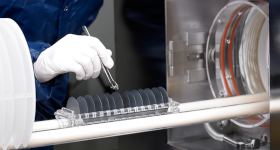Diffusion of Solid Source Dopants
In this process, the wafers are loaded into boats along with solid sources that release B2O3 or P2O5 when heated. The dopant oxide condenses on the wafers and forms a borosilicate or phosphosilicate glass. Dopant atoms then diffuse into the silicon to dope it. Should the application require it, other dopants are available such as Sb2O3 and Zn3P2.
- Sheet Resistance: 1-100 Ω/□
- Batch Size: 50
- Gases: Nitrogen, Oxygen, Hydrogen
- Uniformity: < 10%
The Sb2O3 solid source requires a separate source furnace with operating temperatures from 620 - 660 °C. At those temperatures the vapor pressure of Sb2O3is sufficient for a carrier gas to sweep it into the actual diffusion zone where the silicon wafers are located. The Sb concentration in silicon, or the sheet resistance of the diffused Sb layer, which can be attained depends on:
-
Sb2O3 vapor pressure or Sb2O3 source temperature
Silicon wafer or diffusion temperature
Diffusion time
Antimony diffused layers with sheet resistances of 10 to 60 Ω/□ or surface concentrations from 5 × 1018 to 5 × 1019/cm3 are typically attained. The Sb2O3 diffusion temperature is typically between 1230 °C and 1280 °C and thus requires the high-temperature materials specified above. The gas inlet part of the process tube is extended beyond the actual diffusion zone and extends through a source furnace (a small 3-zone heater), which is attached to the diffusion zone heater. It is essential to have a smooth temperature transition from the source furnace to the diffusion zone. There can be no dip in the temperature or the Sb2O3 vapor concentration cannot be controlled. The temperature in the diffusion zone is controlled to < 1 °C in the diffusion zone over a distance of 34"/860 mm, and in the source heater over a distance of 6"/150 mm.
The Sb2O3 material is introduced into the source furnace in a quartz boat, which is loaded from the gas inlet port of the extended diffusion tube. A tapered quartz flange or a ball joint is used to connect the gas inlet to the process tube. Process gases used for the Sb2O3 diffusion are either a combination of N2 with O2 or pure, dry Argon. The Argon process minimizes the oxidation of Sb2O3 into Sb2O4, which has a much lower vapor pressure than Sb2O3 and results in a reduced consumption of Sb2O3. Several wafer loads can be processed with one charge of Sb2O3 in the source furnace. At the exhaust part of the process tube the Sb2O3 and Sb2O4 condense and can present a particulate problem when the wafers are loaded and unloaded. A condensing cup is normally attached to the source end to capture the condensed Sb2O3 and Sb2O4.
- Sheet Resistance: 5%
- Oxide Thickness: 3%
- Junction Depth: 5%



